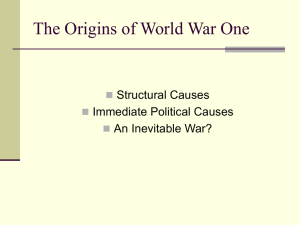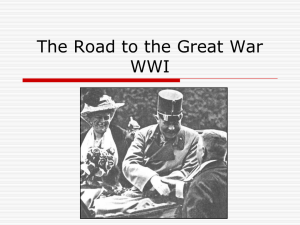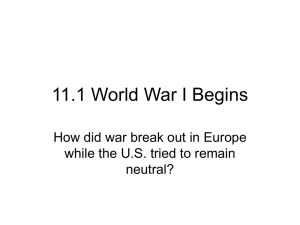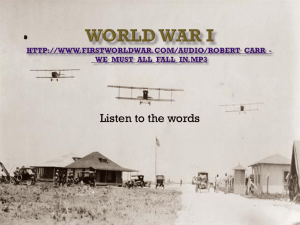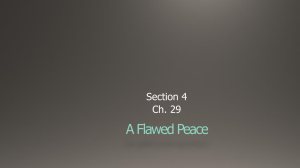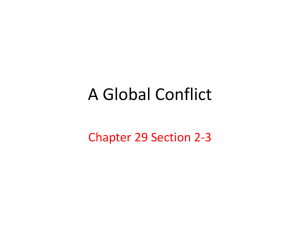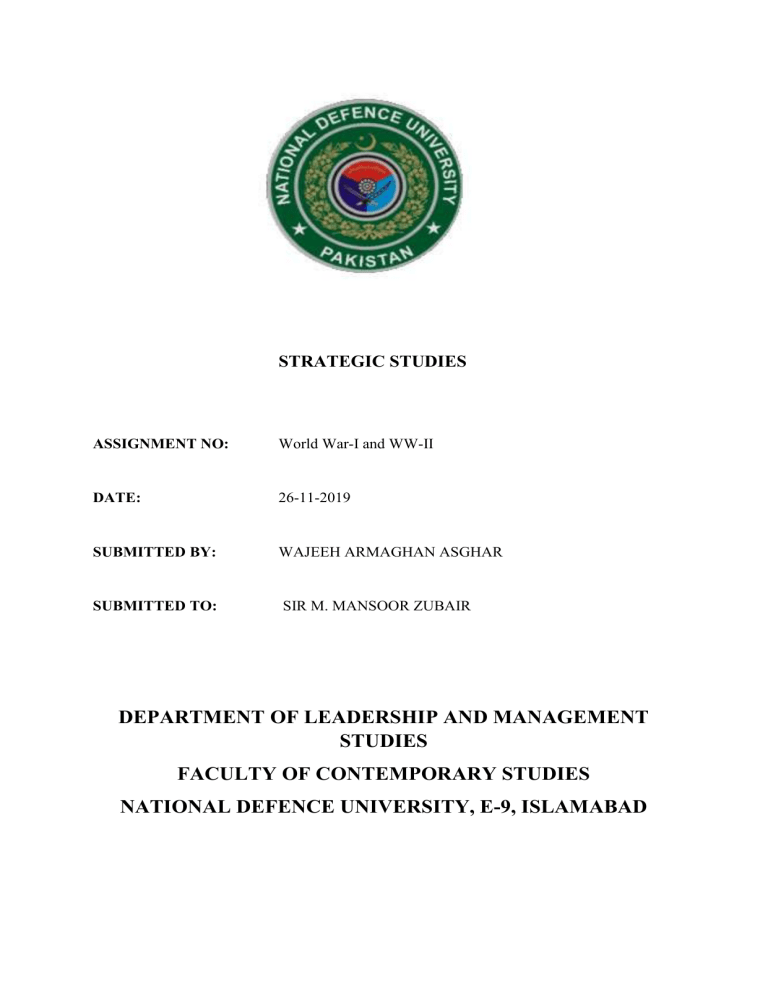
STRATEGIC STUDIES ASSIGNMENT NO: World War-I and WW-II DATE: 26-11-2019 SUBMITTED BY: WAJEEH ARMAGHAN ASGHAR SUBMITTED TO: SIR M. MANSOOR ZUBAIR DEPARTMENT OF LEADERSHIP AND MANAGEMENT STUDIES FACULTY OF CONTEMPORARY STUDIES NATIONAL DEFENCE UNIVERSITY, E-9, ISLAMABAD Q-1: What was the causes of world war I and II? Following are the causes of World War-I; 1. Imperialism is when a country increases their power and wealth by bringing additional territories under their control. Before World War I, several European countries had made competing imperialistic claims in Africa and parts of Asia, making them points of contention. Because of the raw materials these areas could provide. The increasing competition and desire for greater empires led to an increase in confrontation that helped push the world into World War I. 2. Over time, countries throughout Europe made mutual defense agreements that would pull them into battle. These treaties meant that if one country was attacked, allied countries were bound to defend them. Before World War 1, the following alliances existed: Russia and Serbia, Germany and Austria-Hungary, France and Russia, Britain and France and Belgium, Japan and Britain. Austria-Hungary declared war on Serbia, Russia got involved to defend Serbia. Germany seeing Russia mobilizing, declared war on Russia. France was then drawn in against Germany and Austria-Hungary. Germany attacked France through Belgium pulling Britain into war. Then Japan entered the war. Later, Italy and the United States would enter on the side of the allies. 3. As the world entered the 20th century, an arms race had begun. By 1914, Germany had the greatest increase in military build up. Great Britain and Germany both greatly increased their navies in this time period. Further, in Germany and Russia particularly, the military establishment began to have a greater influence on public policy. This increase in militarism helped push the countries involved into war. 4. Much of the origin of the war was based on the desire of the Slavic peoples in Bosnia and Herzegovina to no longer be part of Austria Hungary but instead be part of Serbia. In this way, nationalism led directly to the War. But in a more general way, the nationalism of the various countries throughout Europe contributed not only to the beginning but the extension of the war in Europe. Each country tried to prove their dominance and power. 5. The immediate cause of World War I that made the aforementioned items come into play the assassination of Archduke Franz Ferdinand of Austria-Hungary. In June 1914, a Serbian-nationalist terrorist group called the Black Hand sent groups to assassinate the Archduke. Their first attempt failed when a driver avoided a grenade thrown at their car. However, later that day a Serbian nationalist named Gavrilo Princip assassinated him and his wife while they were in Sarajevo, Bosnia which was part of Austria-Hungary. Following are the causes of World War-I; 1. The Treaty of Versailles ended World War I between Germany and the Allied Powers. Because Germany had lost the war, the treaty was very harsh against Germany. Germany was forced to "accept the responsibility" of the war damages suffered by the Allies. The treaty required that Germany pay a huge sum of money called reparations. The problem with the treaty is that it left the German economy in ruins. People were starving and the government was in chaos. 2. In the period before World War II, Japan was growing rapidly. However, as an island nation they did not have the land or the natural resources to sustain their growth. Japan began to look to grow their empire in order to gain new resources. They invaded Manchuria in 1931 and China in 1937. 3. With the economic turmoil left behind by World War 1, some countries were taken over by dictators who formed powerful fascist governments. These dictators wanted to expand their empires and were looking for new lands to conquer. The first fascist government was Italy 4. 5. 6. 7. which was ruled by the dictator Mussolini. Italy invaded and took over Ethiopia in 1935. Adolf Hitler would later emulate Mussolini in his takeover of Germany. Another Fascist government was Spain ruled by the dictator Franco. In Germany, Adolf Hitler and the Nazi Party rose to power. The Germans were desperate for someone to turn around their economy and restore their national pride. Hitler offered them hope. In 1934, Hitler was proclaimed the leader and became dictator of Germany. Hitler resented the restrictions put on Germany by the Treaty of Versailles. While talking about peace, Hitler began to rearm Germany. He allied Germany with Mussolini and Italy. Then Hitler looked to restore Germany to power by expanding his empire. He first took over Austria in 1938. When the League of Nations did nothing to stop him, Hitler became bolder and took over Czechoslovakia in 1939. After World War 1, the nations of Europe were weary and did not want another war. When countries such as Italy and Germany became aggressive and began to take over their neighbours and build up their armies, countries such as Britain and France hoped to keep peace through "appeasement." This meant that they tried to make Germany and Hitler happy rather than try to stop him. They hoped that by meeting his demands he would be satisfied and there wouldn't be any war. Unfortunately, the policy of appeasement backfired. It only made Hitler bolder. It also gave him time to build up his army. The period before World War II was a time of great economic suffering throughout the world called the Great Depression. Many people were out of work and struggling to survive. This created unstable governments and worldwide turmoil that helped lead to World War II. Q-2: The Countries which took part in World War I? World War I During the conflict, Germany, Austria-Hungary, Bulgaria and the Ottoman Empire (the Central Powers) fought against Great Britain, France, Russia, Italy, Romania, Japan and the United States (the Allied Powers). World War II Axis Powers including Germany, Italy and Japan. And Allies Powers included Britain, France, Australia, Canada, New Zealand, India, the Soviet Union, China and the United States. Q-3: Which leaders emerged during and at the end of WORLD WAR-I? Georges Clemenceau - Clemenceau was Prime Minister of France from 1917 to 1920. His leadership helped hold France together during the most difficult times of the war. His nickname was "The Tiger." Clemenceau represented the French at the peace talks and advocated for harsh punishment for Germany. David Lloyd George - Lloyd George was the Prime Minister of Britain during much of the war. He was an advocate of Britain entering the war and kept the country together during the war. King George V - King of Britain during the war, George V was a figurehead with little power, but often visited the front to inspire the British troops. Tsar Nicolas II - Tsar Nicholas II was leader of Russia at the start of World War I. He entered the war in defence of Serbia. However, the war effort was disastrous in the eyes of the Russian people. The Russian Revolution occurred in 1917 and Nicolas II was removed from power. He was executed in 1918. President Woodrow Wilson - President Woodrow Wilson was re-elected on the platform that he kept America out of the war. However, he was given little choice and declared war on Germany in 1917. After the war, Wilson advocated less harsh terms on Germany, knowing that a healthy German economy would be important for all of Europe. Q-4: What are the turning points of World Wars? The Triple Alliance is formed The Triple Alliance consisted of Germany, Austria-Hungary, and Italy. This alliance was a big factor in the start of World War I. This added to the tangle of alliances which essentially led to war. The Battle of Tannenberg This was one of the most important battles of world war I. Germany defeated Russia in this battle. Russia's equipment was outdated and in short supply. Also, their leaders weren't as strong as Germany's. Russia lost 125,000 soldiers while Germany only lost 13,000 soldiers. Battle of Gallipoli In efforts to open up the strait of the Dardanelles, the allies sent British, Indian, Australian, and New Zealander troops. Turkish troops then trapped the allies. They kept them for ten months then finally the allies withdrew from the Dardanelle. There were more than 200,000 casualties during this battle. The Sinking of Lusitania This ship transported many goods between Britain and the United States. During this time Germany started using U-boats, or submarines, and was sinking ships with them. A German submarine torpedoed Lusitania off the coast of Ireland and killed nearly 1,200 passengers. This contributed to the process of getting the United States involved in the war. The Battle of Verdun In this battle the Germans tried to break the stalemate by attacking the French town of Verdun. They bombarded the city for 24 hours. Then they attacked them with force for about a month. At one point the Germans were close to defeating them but the French fought heroically and stopped them. 315,000 French soldiers were killed and 282,000 German soldiers were killed. The battle like many in world war I accomplished little and it didn't break the stalemate. Battle of Somme The British launched an attack on the Somme River in northwest France to try relieve German pressure on Verdun. With this battle, not much was achieved and there were many casualties. They used new tanks and flamethrowers causing the British and French about 615,000 casualties and German about 650,000. The outcome of this battle was simply that the chief of the German General Staff was removed and replaced and many casualties happened. US declares war on Germany After seeing the Zimmermann note, Wilson declares war. The US spent time recruiting, training, supplying, and transporting their new strong army across the Atlantic. By the time they were ready they had about two million soldiers joining the Allied troops fighting on the Western Front. They didn't actually fight much but they did give confidence to the Allies. Battle of Caporetto The battle of Caporetto was one of the few successes in World War I. Austro-Hungarian forces were nearing the point of collapse so they turned to their German ally. Together they broke through the defensive line along Northern Isonzo. There were about 30,000 Italian casualties and 275,000 Italians were captured. There were about 20,000 Austro-Hungarian and German casualties together. These were big loses but they quickly built back their armies. Fourteen Points Fourteen Points were a list of terms written by the US president, Woodrow Wilson, for resolving this war and preventing future ones. Some of the points were freedom to navigate the seas, no more secret agreements, an end to economic barriers, and self-determination. Wilson presented his fourteen points to his Allied colleagues on January 8th and had trouble accepting them. Some European countries accepted them though, like France and Italy. Treaty of Brest-Litovsk The Treaty was peace agreement between Central Powers and Russia. It was a peace treaty in force for only eight months. Turkey forced Germany into signing it. It stated "Germany, Austria-Hungary, Bulgaria, and Turkey for the one part, and Russia for the other part, being in accord to terminate the state of war, and to enter into peace negotiations as speedily as possible". Q-5: how the both World Wars ended? WW-I: This first global conflict had claimed from 9 million to 13 million lives and caused unprecedented damage. Germany had formally surrendered on November 11, 1918, and all nations had agreed to stop fighting while the terms of peace were negotiated. On June 28, 1919, Germany and the Allied Nations including Britain, France, Italy and Russia signed the Treaty of Versailles, formally ending the war. The Treaty of Versailles imposed very rigid restrictions against Germany, including limiting its army to 100,000 members. President Wilson, who opposed the treaty, had developed his own form of reconciliation, called the "Fourteen Points." The Points included a provision for a League of Nations to prevent "the crime of war." Wilson also wanted all terms of settlement to be openly negotiated. But the actual terms of the treaty included secret arrangements for distribution of conquered German territories among the Allied Nations. Many historians believe these terms eventually led to World War II. WW-II: World War II ended with the unconditional surrender of Germany in May 1945, but both May 8 and May 9 are celebrated as Victory in Europe Day (or V-E Day). This double celebration occurs because the Germans surrendered to the Western Allies, including Britain and the U.S., on May 8, and a separate surrender took place on May 9 in Russia. In the East, the war ended when Japan surrendered unconditionally on Aug. 14, 1945, signing their surrender on Sept. 2. The Japanese surrender occurred after the United States dropped atomic bombs on Hiroshima and Nagasaki on Aug. 6 and 9, respectively. The date of the Japanese surrender is known as Victory Over Japan Day, or V-J Day. Q-4: What were the effects of both wars on large scale? Specific Effects of World War 1: WW1 caused the downfall of four monarchies: Germany, Turkey, Austria-Hungary and Russia. The war made people more open to other ideologies, such as the Bolsheviks that came to power in Russia and fascism that triumphed in Italy and even later in Germany. WW1 largely marked the end of colonialism, as the people became more nationalistic and the one country after the other started colonial revolts in Southeast Asia, the Middle East and Africa. The war changed the economical balance of the world, leaving European countries deep in debt and making the U.S. the leading industrial power and creditor in the world. Inflation shot up in most countries and the German economy was highly affected by having to pay for reparations. With troops travelling all over the world, influenza was spread easily and an epidemic started which killed more than 25 million people across the world. With all the new weapons that were used, WW1 changed the face of modern warfare forever. Specific Effects of World War 2: At the end of World War II, huge swaths of Europe and Asia had been reduced to ruins. Borders were redrawn and homecomings, expulsions, and burials were under way. But the massive efforts to rebuild had just begun. When the war began in the late 1930s, the world's population was approximately 2 billion. In less than a decade, the war between the Axis the Allied powers had resulted in 80 million deaths -- killing off about 4 percent of the whole world. Allied forces now became occupiers, taking control of Germany, Japan, and much of the territory they had formerly ruled. Efforts were made to permanently dismantle the war-making abilities of those nations, as factories were destroyed and former leadership was removed or prosecuted. War crimes trials took place in Europe and Asia, leading to many executions and prison sentences. Millions of Germans and Japanese were forcibly expelled from territories they called home. Allied occupations and United Nations decisions led to many long-lasting problems in the future, including the tensions that created East and West Germany, and divergent plans on the Korean Peninsula that led to the creation of North and South Korea and -- the Korean War in 1950. The United Nations Partition Plan for Palestine paved the way for Israel to declare its independence in 1948 and marked the start of the continuing Arab-Israeli conflict. The growing tensions between Western powers and the Soviet Eastern Bloc developed into the Cold War, and the development and proliferation of nuclear weapons raised the very real specter of an unimaginable World War III if common ground could not be found. World War II was the biggest story of the 20th Century, and its aftermath continues to affect the world profoundly more than 65 years later.
